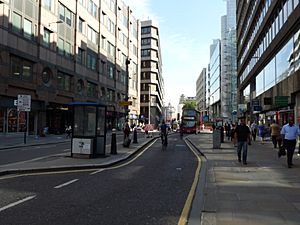Traffic and Environmental Zone facts for kids
The Traffic and Environmental Zone, often called the "ring of steel", is a special security system. It protects the City of London, which is a busy financial area in the heart of Greater London. This system includes road barriers, checkpoints, and hundreds of CCTV cameras. It has been used since the 1990s. Its main purpose is to prevent terrorism and other threats.
Contents
What is the Ring of Steel?
Why was it created?
The "ring of steel" was introduced by Owen Kelly. He was the police chief for the City of London Police. This happened after a series of bombings by the Provisional IRA in London. These attacks took place in the 1980s and early 1990s. Some major attacks happened right in the City, like the 1992 Baltic Exchange and 1993 Bishopsgate bombings. The "Traffic and Environmental Zone" officially began in 1993.
The name "ring of steel" came from an earlier time. It was used to describe a fortified area in Belfast. That area was also made strong to protect against attacks.
How does it work?
Roads leading into the City were made narrower. Small zig-zag paths, called chicanes, were built. These forced drivers to slow down. This allowed CCTV cameras to record them. These roads often had concrete islands. They also had small sentry boxes. Police officers could stand there to watch traffic. City planners sometimes call these security steps "fortress urbanism." Some roads were even completely closed to cars.
Even though it's called the "ring of steel," the barriers were mostly made of concrete blocks. Sometimes these blocks had a plastic coating. They were fitted together to create the checkpoints.
At first, armed police officers often staffed the sentry posts. The early "ring of steel" used plastic cones and police. Locals sometimes called it the "ring of plastic." It showed people that the City was serious about stopping attacks. Later, more permanent structures were built. These included concrete barriers, checkpoints, and many video cameras. After the IRA stopped fighting, fewer police were needed at these posts.
Attacks outside the ring
In 1996, the IRA bombed another part of central London. This was the 1996 Docklands bombing. It caused deaths and injuries. This attack showed that even if the City itself was safe, terrorists could target other important areas. Places like the Docklands or Westminster could still be at risk.
Changes over time
Staffed checkpoints started to be removed after 1994. This was when the IRA announced a ceasefire. By the end of the 1990s, they were no longer used.
After the September 11 attacks in the United States in 2001, security was increased again. There were occasional spot checks on cars entering the City. However, this was not as strict as before. In December 2003, the "ring of steel" was made wider. It included more businesses in the City. This happened because a police report said a terrorist attack on the City was "inevitable." Traffic entering the City is also watched and recorded. This happens at the edge of the London congestion charging zone. That zone covers a much larger area.
Future plans
In December 2016, new ideas were suggested. These included bringing back staffed checkpoints and restricted roads. They also proposed rising street barriers and crash-proof barricades. These ideas aim to fight "hostile vehicle-borne security threats." If approved, these changes could be fully in place by 2022.
How Many Cameras Are There?
According to a request made in 2011, the City of London had 649 CCTV cameras. These cameras were operated by the local government.
People often wrongly say there are 500,000 cameras in the "ring of steel." This number is actually for Greater London. Greater London is a very large area. It is about 607 square miles (1,572 square kilometers). The "ring of steel" only covers the City of London. That area is just one square mile (3 square kilometers). Also, experts have known for years that the way this 500,000 figure was calculated was not correct. But it has been widely repeated.
The 500,000 figure came from a study in 2002. Researchers looked at a small area in Putney High Street. From that small sample, they guessed there were 500,000 cameras in Greater London. They also guessed 4.2 million in the whole United Kingdom. More accurate estimates from 2011 suggest there are about 1.85 million cameras in the whole United Kingdom. This includes both private and government cameras.
See also
- Automatic number plate recognition in the United Kingdom
- Lower Manhattan Security Initiative
- Mass surveillance in the United Kingdom


